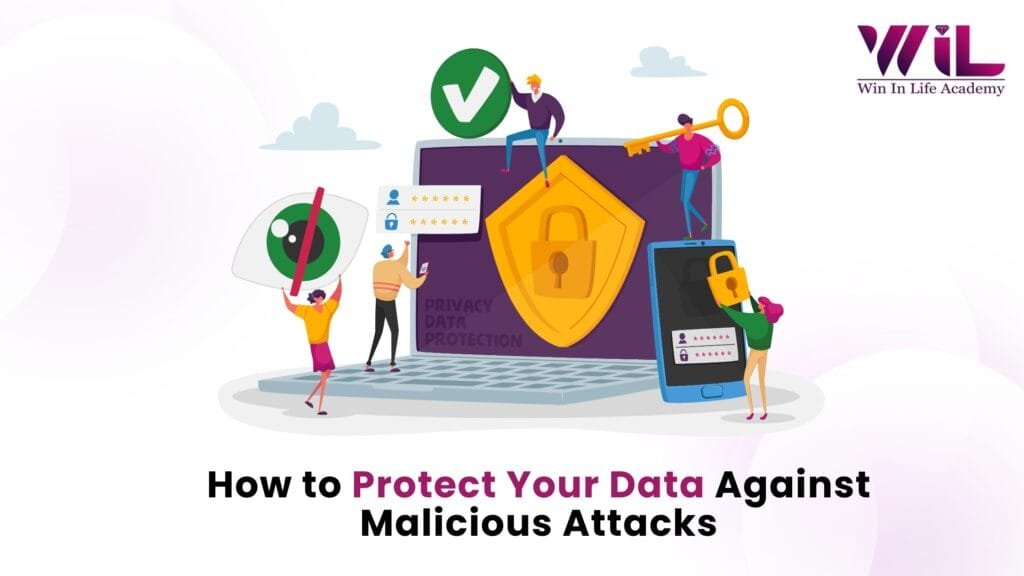Data Privacy in Cybersecurity: Its Shielding Secrets in 2025
In this hyper-connected world, data privacy in cybersecurity is the new gold. But with this wealth comes immense responsibility to protect the information from prying eyes and malicious actors is no longer an option. It is the fundamental necessity, and this is where data privacy in cybersecurity takes centre stage, acting as the guardian of our digital lives.
Data privacy and cybersecurity are inextricably linked. While cybersecurity focuses in defending systems and networks from threats, data privacy in cybersecurity emphasizes the ethical and legal handling of personal information. Essentially, cybersecurity builds the walls, while data privacy dictates who gets the keys and what they can do inside.
According to TechTarget, the median number of record compromised per data breach is projected to be around 42 million in 2025. Spacelift found that it is found that the average cost of a single data breach hit at an all-time high by $4.88 million in 2024 with a 10% jump from the year 2023. Additionally, the average cost stands at $3.31 million as organizations spent 13.4% more to manage the data breaches in the last year.
By understanding the key differences between data protection and cybersecurity will help you with the better understand the unique perspective and benefits. It is specifically beneficial when it comes to ensuring customer privacy.
What is the difference between Data Protection and Cybersecurity?

Although closely related, data protection and cybersecurity serve distinct but complementary purposes. Data protection emphasizes safeguarding the integrity and confidentiality of data itself, focusing on measures like encryption, access control, and backup strategies. In contrast, cybersecurity adopts a wider scope, encompassing the defence of entire digital ecosystems, including networks, systems, and devices, against a range of threats. While data protection is critical component of cybersecurity, the letter extends beyond data alone to ensure the overall security and resilience of digital infrastructure.
What is cybersecurity?
Cybersecurity encompasses the crucial practice of safeguarding systems, networks, and programs against digital attacks. The primary objectives of these attacks typically involve unauthorized access, modification, or destruction of sensitive data, financial extortion through ransomware, or disruption of essential business operations. The complexity of establishing robust cybersecurity measures is heightened in today’s digital landscape, characterized by a proliferation of interconnected devices exceeding the global population, coupled with the ever-evolving sophistication of cyber adversaries.
A comprehensive cybersecurity strategy necessitates a multi-layered defence system, strategically deployed across computers, networks, programs, and data assets requiring protection. Within organizational frameworks, a unified threat management gateway system can streamline security operations by automating integrations between various security tools, thereby accelerating critical functions such as threat detection, investigation, and remediation. Achieving effective cyber defence requires a synergistic approach, where people, processes, and technology seamlessly complement each other to create a formidable barrier against cyberattacks.
A robust cybersecurity strategy relies on several essential pillars.
- Endpoint security is fundamental, ensuring all devices, from laptops to mobile phones, are consistently updated with the latest security patches to prevent vulnerabilities.
- Identity and Access Management (IAM) plays a crucial role in controlling access to sensitive information, adhering to a “need-to-know” principle, thus limiting potential damage from compromised accounts.
- Network security involves continuous monitoring of network traffic for anomalies and suspicious activities, enabling prompt detection and response to potential intrusions.
- Data security focuses on safeguarding data integrity and confidentiality, preventing unauthorized modifications or access that could lead to data breaches.
- Application security is paramount, demanding that all applications are regularly patched and hardened against exploitation by cybercriminals, ensuring they cannot be leveraged as entry points for attacks.
The main objective of cybersecurity is to keep unauthorized users to access the data. The attackers use various methods to steal data that is called data exfiltration.
What is data protection?
Data protection, at its core, is about maintaining the reliability and privacy of information. It goes beyond simply defending against malicious cyberattacks; it also encompasses safeguarding data from unintentional alterations. This means that data protection strategies must account for human error, such as when an employee inadvertently corrupts data through incorrect input, alongside the more commonly considered threats of deliberate data breaches. Essentially, it’s a holistic approach to ensuring data remains accurate and confidential, regardless of the cause of potential compromise.
Effective data protection relies on a variety of controls, each serving a distinct purpose.
- Encryption transforms data into an unreadable format, ensuring confidentiality.
- Masking conceals sensitive details, limiting exposure while maintaining data utility.
- Erasure permanently removes data, preventing unauthorized retrieval.
- Backups create redundant copies, enabling recovery and restoration in the event of data loss or corruption.
These measures collectively contribute to a robust data protection strategy, safeguarding information from unauthorized access and potential breaches.
Why is privacy important in cybersecurity?

Privacy is crucial in cybersecurity because it safeguards sensitive information from unauthorized access, use, disclosure, modification, or destruction, which is essential for maintaining trust, complying with regulations, and protecting individuals and organizations from harm.
- Protecting Sensitive Data: Cybersecurity measures are vital to protect sensitive data, including personal information, financial details, and confidential business data, from cyber threats and breaches.
- Maintaining Trust: Privacy is a fundamental right and ethical responsibility, and protecting it builds trust between individuals, businesses, and organizations.
- Compliance with Regulations: Data privacy regulations, such as GDPR and CCPA, require organizations to implement robust security measures to protect personal data.
- Preventing Identity Theft and Fraud: Cybersecurity measures, including strong authentication and data encryption, help prevent identity theft and other forms of fraud.
- Enhancing Reputation and Credibility: Organizations that prioritize cybersecurity and data privacy enhance their reputation and credibility, which can lead to increased customer loyalty and business opportunities.
- Safeguarding Personal Lives: Protecting personal information and ensuring the confidentiality of individuals’ data is crucial for maintaining privacy and personal autonomy.
- Cybersecurity and Privacy are Intertwined: While security focuses on protecting systems and data from unauthorized access, privacy focuses on protecting the information itself.
- Ethical Considerations: Cybersecurity professionals have an ethical responsibility to protect the privacy of individuals and organizations, even when facing conflicting interests or pressures.
- Transparency and Accountability: Organizations should be transparent about their data collection and usage practices, and they should be accountable for protecting the privacy of individuals’ data.
While cybersecurity establishes essential access controls and security measures, it alone is insufficient to address the full spectrum of user rights mandated by privacy laws. A robust and comprehensive program, encompassing both cybersecurity and data privacy, necessitates a holistic approach. This involves integrating appropriate technologies, cultivating skilled personnel, and establishing well-defined processes to ensure adherence to all three critical requirements: security, access control, and compliance with privacy regulations.
Why Data Privacy in Cybersecurity is Crucial?

The function of data privacy in cybersecurity are manifold, all aimed at safeguarding the confidentiality, integrity, and availability of personal data. Let’s explore some key aspects:
- Confidentiality: This ensures that sensitive information is accessible only to authorized individuals. Strong encryption, access controls, and robust authentication mechanisms are vital components of maintaining confidentiality.
- Integrity: Data integrity guarantees that information remains accurate and unaltered. Digital signatures, checksums, and secure data storage practices are employed to prevent unauthorized modifications.
- Availability: While protecting data, it’s also essential to ensure that authorized users can access it when needed. Redundant systems, backups, and disaster recovery plans play a critical role in maintaining availability.
- Compliance: Numerous regulations, such as GDPR, CCPA, and HIPAA, mandate strict data privacy practices. Implementing robust data protection in cyber security measures helps organizations comply with these legal requirements, avoiding hefty fines and reputational damage.
- Building Trust: Demonstrating a commitment to data protection cyber security fosters trust among customers and stakeholders. In an era where data breaches are commonplace, transparency and accountability are paramount.
Benefits of Combining Cybersecurity and Data Privacy
Given the foundational nature of privacy as a human right, and the pervasive integration of digital tools within modern organizations, cybersecurity and data privacy have become inherently linked. By implementing a comprehensive strategy that addresses both domains simultaneously, organizations can not only strengthen their cybersecurity defenses but also ensure the protection of consumer rights, fostering a more secure and trustworthy digital environment.
Prevent Data Breaches
A common misconception is that data breaches originate solely from external threats. However, internal vulnerabilities pose a significant risk, as many privacy laws, including the GDPR, recognize. Employees with unnecessary access to sensitive data are considered a potential breach point, even without malicious intent. A prominent early GDPR fine illustrated this, stemming from excessive employee access permissions rather than actual data theft. The mere ability for employees to view sensitive information they don’t require constitutes a privacy violation, highlighting the importance of stringent access controls and data minimization within organizations.
Stay GDPR Compliant
The General Data Protection Regulation (GDPR) stands out as a pioneering piece of legislation due to its extraterritorial reach, mandating compliance from any company, regardless of its geographic location, that handles the sensitive data of European Union citizens or residents. Furthermore, the regulation extends responsibility to include third-party vendors who process data on behalf of the company, necessitating both internal compliance and the selection of GDPR-compliant partners to ensure comprehensive data protection.
Build Customer Trust
Building customer trust hinges on demonstrating robust data protection. In an era where identity theft is a pervasive concern, customers are understandably wary of data breaches. A company’s vulnerability to such incidents can severely erode customer confidence, leading to a loss of business as individuals seek out competitors perceived as more secure. Therefore, prioritizing cybersecurity is not just about safeguarding data, but also about protecting customer relationships and ensuring long-term business viability.
Protect Revenue
The financial ramifications of data breaches and privacy law violations are substantial, impacting businesses through various avenues. By integrating robust enterprise cybersecurity with stringent data privacy measures, organizations can significantly mitigate these costs. This proactive approach directly translates to reduced expenses associated with:
- Business Interruption: Minimizing downtime and operational disruptions following a security incident.
- System Recovery: Lowering the expenses involved in restoring compromised systems and data.
- Customer Notification: Reducing the costs associated with informing affected customers about data breaches.
- Fines: Avoiding or minimizing financial penalties imposed by regulatory bodies for non-compliance with data privacy laws.
- Lawsuits: Decreasing the risk and associated costs of legal actions stemming from data breaches and privacy violations.
How to Protect Your Data Against Malicious Attacks
When you follow cybersecurity best practices and protect data privacy at the same time, you mitigate malicious attack risks.
Implement Multi-Factor Authentication
As part of an attack, many cybercriminals use stolen user credentials, like user ID and password. Multi-factor authentication (MFA) requires users to input additional information when they login, like a passcode sent to a smartphone or email address. Since the user needs to have their device with them, this provides another layer of confidence that they are who they say they are.
Limit User Access
When you limit user access according to the principle of least privilege, you grant only the access someone needs to complete their job function. By doing this, you mitigate privacy risks like accidentally viewing sensitive information even though they’re an authorized user.
Use a Botnet Detection Solution
Cybercriminals use botnets for various attacks, including DDoS and credential stuffing. A bot detection solution helps you mitigate risk by analysing both technical and behavioural data to identify fraudulent traffic.
Continuously Monitor Security
As cybercriminals look for different ways to attack companies, the protections that you implemented may no longer be effective. You need to continuously monitor your devices, systems, and networks to ensure that everything is doing what you expect it to do.
Update Operating Systems and Software Quickly
Vulnerabilities are coding issues that create security weaknesses. Companies supply patches to fix them so that cybercriminals can’t use them during an attack. The sooner you install security updates, the more protected you are.
The Threat Landscape: Cyber Security Data Breach
The consequences of neglecting data privacy in cyber security can be devastating. A cyber security data breach can lead to:
- Financial losses: From direct theft to regulatory fines and legal fees.
- Reputational damage: Eroding customer trust and brand loyalty.
- Identity theft: Exposing individuals to fraud and other malicious activities.
- Operational disruption: Causing significant downtime and business interruption.
Strengthening Your Defences:
To effectively implement data protection in cyber security, organizations should focus on:
- Risk Assessments: Regularly identify and assess potential vulnerabilities.
- Encryption: Encrypt sensitive data both in transit and at rest.
- Access Controls: Implement strict access controls and least privilege principles.
- Employee Training: Educate employees about data privacy best practices and security awareness.
- Incident Response: Develop a comprehensive incident response plan to handle data breaches effectively.
- Data Minimization: Only collect and store the data that is absolutely necessary.
- Regular Security Audits: Conduct regular audits to ensure that security measures are effective.
Data privacy in cybersecurity is not just a technical challenge. It is a fundamental, ethical, and legal imperative. By prioritizing data privacy, organizations can build stronger defences, foster trust, and navigate the complex space of the digital age with confidence.
Why Win in Life Academy for Cybersecurity?
Win in Life Academy offers cybersecurity course by emphasizing placement assistance, a key draw for many aspiring graduates and professionals. With over 500+ established corporate connections, we aim to bridge the gap between academia and industry. WILA provides industry relevant curriculum especially designed to equip you with hands-on practical and in-demand skills required by employers. This practical training includes real-world case studies, and instructions relevant for industry professionals.
With the cohesive learning experience, Win in Life Academy focuses on well-rounded education and smooth transition to your profession. In addition, we are also providing preparation for recognized industry certifications that enhances your credentials and marketability. Enroll for Cybersecurity Course your career growth and expansion.





